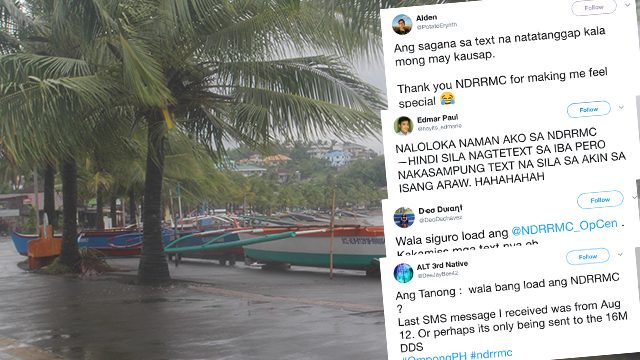SUMMARY
This is AI generated summarization, which may have errors. For context, always refer to the full article.

MANILA, Philippines – As Typhoon Ompong (Mangkhut) heads for land, practically the entire Luzon has been affected, with Isabela and Cagayan expected to be the hardest hit.
Both the national government and local government units are on alert, preparing to respond to the onslaught of the typhoon.
One thing, though, seemed to be missing for some Filipinos. People took to social media to ask: Where are the mobile emergency warnings? (READ: How NDRRMC issues its emergency mobile warnings)
The National Disaster Risk Reduction and Management Council (NDRRMC) wants citizens to be informed about what to expect and what they must do during disasters, that’s why it issues emergency mobile alerts.
But part of making mobile warnings effective is to ensure that they are crafted to be hazard-specific, area-focused, and time-bound.
In the case of Ompong, NDRRMC 24/7 Operations Center Officer-in-Charge (OIC) Aimee Menguilla told Rappler that mobile warnings have only been issued in areas under Signal Nos. 2 and 3.
“These (messages) are area-focused. Mobile warnings have been sent to those in areas under…Signal Nos. 2 and 3 only. So in Metro Manila, there have been no messages sent because it’s under Signal No. 1,” she said.
True enough, some shared that they got the mobile warnings from the NDRRMC:
Thanks @NDRRMC_OpCen sa walang sawang updates! Signal # 2 na pala rito sa amin. Okay ito na via text message niyo kami iniinform lalo na’t pawala-wala ang aming internet connection dahil sa ulan. Keep safe everyone!
— Kristine Dot (@itscapitalK) September 14, 2018
Ang sagana sa text na natatanggap kala mong may kausap.
— Alden (@PotatoErynth) September 14, 2018
Thank you NDRRMC for making me feel special
NALOLOKA NAMAN AKO SA NDRRMC
— Edmar Paul (@heyits_edmarie) September 14, 2018
—HINDI SILA NAGTETEXT SA IBA PERO NAKASAMPUNG TEXT NA SILA SA AKIN SA ISANG ARAW. HAHAHAHAH
If you haven’t received any mobile warning on Ompong, chances are you’re in an area that isn’t observing heavy rainfall.
For rainfall warnings, the NDRRMC sends mobile alerts every 3 hours based on the orange and red warnings issued by the Philippine Atmospheric, Geophysical, and Astronomical Services Administration (PAGASA). (READ: FAST FACTS: Tropical cyclones, rainfall advisories)
NDRRMC Information and Communications Technology OIC Kelvin Ofrecio also assured the public that the mobile warnings have not been discontinued.
“We are sending these emergency alert warning messages to [the most] affected areas only,” he said.
NDRRMC SMS – Curated tweets by rapplerdotcom
The NDRRMC and telecommunications companies are required by law to send free mobile alerts before disasters happen. This is mandated under Republic Act No. 10639 or the Free Mobile Disaster Alerts Act. – Rappler.com
News you can use during Typhoon Ompong (Mangkhut):
- Weather updates and storm signals
- Reports on evacuation, emergencies, and rescue and relief efforts
- Typhoon Ompong: Free parking at SM, Ayala, Robinsons, Megaworld malls
- #WalangPasok: Class suspensions for September 13, 14, 15
- Canceled flights due to Typhoon Ompong
- Will Typhoon Ompong be the same as Super Typhoon Lawin?
- What gov’t has done so far to prepare for Typhoon Ompong
- Fact-check on viral stories related to Typhoon Ompong
Add a comment
How does this make you feel?
There are no comments yet. Add your comment to start the conversation.